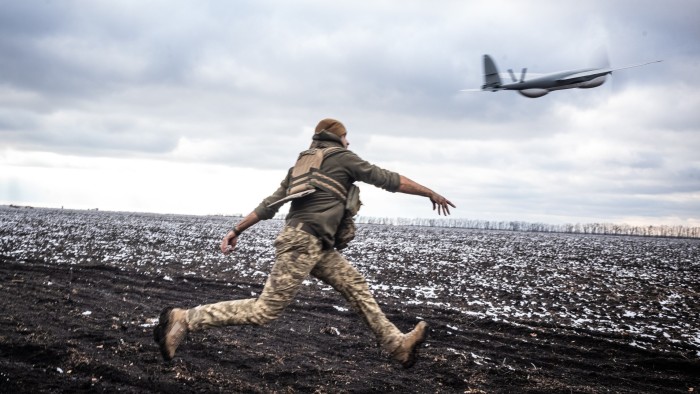“Two years ago we were two steps ahead of the Russians,” according to Oleksandr Yakovenko, chief executive of one of Ukraine’s largest drone manufacturers. “Now, though, we are just one step ahead of them.”
Just last month, Russian soldiers raced on motorcycles across Ukrainian territory in such numbers that it was impossible for Kyiv’s forces to deploy enough drones to stop them all, he recalled.
“Right now [the battlefield] is not about new technology,” Yakovenko told the Financial Times in his headquarters in the Black Sea port of Odesa. “It’s about how to adapt to new strategies.”
The ingenuity of Ukraine’s drone start-ups has been a rare bright spot for its economy and its campaign to stall the Russian advance. In the past two years the Ukrainian front line has increasingly been dominated by drones, which all but control a 10-15km-wide no man’s land. Moscow has also revolutionised its use and provision of drones, with devastating effects not just on the battlefield but also on cities.
Yakovenko, 35, the founder of TAF Drones, is at the forefront of this revolution as the war has tilted from its initial dependence on heavy artillery to this more high-tech combat.
Launched from scratch in the early months of Russia’s full-scale invasion in 2022, his company made 350,000 drones last year, out of a total of about 2mn made in Ukraine in 2024. It has contracts from the Ukrainian government for the same amount in the first six months of this year alone, and is hoping to expand production of constituent parts into Europe.
But Yakovenko is not celebrating. He spoke of the challenges and complexity of the drone war — from countering sophisticated Russian drone jamming systems, to having to rethink the supply chain.
For the past three years China has provided most of the thermal cameras, carbon frames and battery cells for the cheap first-person-view drones that are the footsoldiers of the drone war. Yakovenko said he spent $1.2bn in the past 18 months on Chinese components, often relying on third parties to evade export controls.
But the trade tensions between Washington and Beijing have intensified the effects of a Chinese clampdown, introduced last September, on exports of key components, including sensors for thermal cameras. Ukrainian drone companies are finding it harder to evade the restrictions.
“Even after a few weeks of the trade war we have a huge problem,” said Yakovenko. “We are having to delay orders by a month because of the crackdown.” There are only a handful of European companies that manufacture such parts, and their products are much more expensive than the Chinese ones.
Yakovenko is also under no illusions about the shape-shifting Russian threat. “We tend to innovate first. But when we create something new they quickly come up with a response.”

One of the more successful recent Russian innovations has been the use of fibre-optic drones that cannot be jammed, as they rely on a cable about the breadth of a human hair for communication, rather than radio signal.
While Yakovenko said they were not a game-changer due to the cable’s range being limited to 20km and often breaking in sub-zero temperatures, he expects an increased use this summer, having been manufactured in Shanghai, where the winters are far warmer than in Ukraine.
Ukraine’s drone war has been hailed as foreshadowing a new age of warfare, but it is a revolution that Ukrainians argue western militaries have been slow to appreciate. “It’s well understood in Ukraine, Russia and China but not in other places,” Valeriy Zaluzhnyi, Ukraine’s former head of army and now ambassador to the UK, told a Royal United Services Institute conference in London last week.
Yakovenko and other drone manufacturers are now being wooed by western militaries and companies for insight and partnerships. There is a growing expectation in the sector that Volodymyr Zelenskyy, Ukraine’s president, will this year allow the export of drones to Europe.
“We have a lot of good companies with very good technology and they would like to make their products in Europe,” said Yakovenko. But most European governments would rather invest in their own companies. “A lot of foreigners use our war for education. We understand that. It’s OK. They help us too.”

Yakovenko often wears a hoodie emblazoned with the words “Get”, “Hit” and “Repeat”, punctuated by the images of a drone, a tank and three arrows encircling a drone.
The former logistics company director turned drone manufacturer embodies the resilience Ukraine has displayed against its far stronger enemy — which it will need if the war goes on and the Trump administration withdraws America’s support for Kyiv as it has threatened to do.
Yakovenko’s headquarters is in Odesa, which is regularly hit by Russian drones and missiles. Every two months he moves his production centre for security.
On the morning of Russia’s full-scale invasion he wrote to his staff: “Guys you have four hours to make up your mind. Leave. Or if you stay, we will do our best to help our military.”
Almost all stayed and helped him to pivot from delivering commodities to taking supplies to the front line. It was on one such trip in 2022 that he saw soldiers modifying a sports drone for the battlefield; it set his mind racing. He founded a charity that assembled hundreds of drones a month for the front.
Then he was summoned to Kyiv to see Mykhailo Fedorov, the minister overseeing drones. Fedorov, he recalls, told him: “It’s very cool you’ve started a charity and are providing drones for free but please build a business. We need to be competitive.”
One of the reasons western defence companies have been reluctant to invest in drone production is that the pace of change is relentless, he said.
The cult drone of today is often redundant within months as new models emerge. In 2023 the average distance for a kamikaze drone that explodes on impact was 5km with a payload of about 1kg, he said. “Now they can go 40km with a payload of 3kg.”
For 2025, he predicts an increased use of land drones: “It will be the year of robots with wheels. They will be used to evacuate people from the front, and if we need to send supplies to the front we don’t need to risk sending people.”
The rapid development of artificial intelligence means that pilots of “first person view” (FPV) drones may soon no longer have to be at the front line to steer them, and instead can be in an office hundreds of miles away.
But while Ukraine still has the edge over Russia at innovating, he cautioned that when it came to production, Moscow had proved more efficient. “Russia goes step by step. If it continues [like this] for two years it will be impossible [for us] to go on defending.”
Read the full article here




